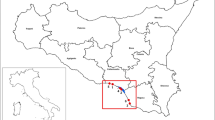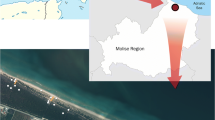Abstract
We investigated the temporal and spatial changes in the floristic composition and abundance in sand dunes along a coastal strip in the province of Buenos Aires (Argentina). Firstly, we analysed changes over a span of 70 years, comparing 41 of our own inventories carried out in 14 beach resorts in 2005–2006 with 18 inventories made in the first half of the XXth century (1930–1940) in the same study area. We grouped sampled plots into four categories for comparison, taking into account the time period (1930–1940 or 2005–2006) and location at each end of the surveyed coastal strip in the northern or southern ‘tourist’ sectors. Secondly, we analysed the effect of afforestation with exotic trees on extant sand dune vegetation for the period 2005–2006. A total of 74 plant inventories were carried out in afforested and natural dunes at the same resorts. In both comparisons we contrasted plant richness, percentage plant cover, similarity and diversity. A cluster analysis was used to classify categories taking into account plant abundance and composition. Significant differences in total diversity were observed between sampling years, suggesting an increase in diversity at the present time due to urbanization and recreation related activities. Nevertheless, no single exotic plant species was clearly dominant across the sampled sites, suggesting that these coastal areas are, up to now, resistant to alien invasion. Diversity indexes discriminated by plant groups indicating different habitat conditions and exotics were shown to be more sensitive to existing changes than to total richness and cover.






Similar content being viewed by others
References
Avis AM (1989) A review of coastal dune stabilization in the Cape Province of South Africa. Land Urb Plan 18(1):55–68
Bond WJ, Parr CL (2010) Beyond the forest edge: ecology, diversity and conservation of the grassy biomes. Biol Cons 143:2395–2404
Cabrera AL (1941) Las comunidades vegetales de las dunas costaneras de la Provincia de Buenos Aires. DAGI 1(2):1–44
Carnus JM, Parrotta J, Brockerhoff E, Arbez M, Jactel H, Kremer A, Lamb D, O’Hara K, Walters B (2006) Planted forests and biodiversity. J For 104(2):65–77
Connell JH (1978) Diversity in tropical rain forests and coral reefs. Science 199(4335):1302–1310
Curr RHF, Koh E, Williams AT, Davies P (2000) Assessing anthropogenic impact on Mediterranean sand dunes from aerial digital photography. J Coast Cons 6:15–22
Dadon J, Matteucci SD (2009) Environmental and coastal management. In: Chircop A, Coffen-Smout S (eds) Ocean yearbook 23. Dalhouise University Law School and Transnational Publishers, Halifax, 1006 pp
Defra (2007) Management for flood and coastal defence Part 4: Techniques for sand dune management R&D Technical Report FD1302/TR London, 49pp
Doody JP (2005) Shoreline management—conservation, management or restoration? In: Herrier J-L, Mees J, Salman A, Seys J, Van Nieuwenhuyse H, Dobbelaere I (eds) Proceedings ‘Dunes and Estuaries 2005’—International Conference on Nature Restoration Practices in European Coastal Habitats. Koksijde, Belgium, pp 407–419
Ehrenfeld JG, Kourtev P, Huang WZ (2001) Changes in soils functions following invasions of exotic understory plants in deciduous forests. Ecol Appl 11:1287–1300
El-Keblawy A, Ksiksi T (2005) Artificial forests as conservation sites for the native flora of the UAE. For Ecol Manag 213:288–296
Faggi A, Ignatieva M (2009) Urban green spaces in Buenos Aires and Christchurch. ICE Muen 62:241–250
Faggi A, Krellenberg K, Arriaga M, Castro R, Endlicher W (2006) Biodiversity in the Argentinean rolling pampa ecoregion: changes caused by agriculture and urbanisation. Erdk 60:127–138
Faggi A, Perepelizin P, Dadon J (2010) South Atlantic tourist resorts: predictors for changes induced by afforestation. In: Müller N, Werner P, Kelcey JG (eds) Urban biodiversity and design. Wiley-Blackwell, Oxford, pp 363–378
Fearnehough W, Fullen MA, Mitchell DJ, Trueman IC, Zhang J (1998) Aeolian deposition and its effect on soil and vegetation changes on stabilised desert dunes in northern China. Geomorphology 23:171–182
García-Mora MR, Gallego-Fernández JB, García-Novo F (2000) Plant diversity as a suitable tool for coastal dune vulnerability assessment. J Coast Res 16(4):990–995
García-Mora MR, Gallego-Fernández JB, Williams AT, García-Novo F (2001) A coastal dune vulnerability classification. A case study of the SW Iberian Península. J Coast Res 17(4):802–811
Grunewald R, Schubert H (2007) The definition of a new plant diversity index “H’dune” for assessing human damage on coastal dunes—derived from the Shannon index of entropy H’. Ecol Ind 7:1–21
Kim KD (2005) Invasive plants on disturbed Korean sand dunes. Est Cost Shelf Sci 62:353–364
Kutiel P, Cohen O, Shoshany M, Shubb M (2004) Vegetation establishment on the southern Israeli coastal sand dunes between the years 1965 and 1999. Land Urb Plan 67:141–156
Le Maitre DC, van Wilgen BW, Gelderblom CM, Bailey C, Chapman RA, Nel JA (2002) Invasive alien trees and water resources in South Africa: case studies of the costs and benefits of management. For Ecol Manag 160:143–159
Lemauviel S, Rozé F, Clément BA (2005) Study of the dynamics of the seed banks in a complex dune system, with the aim of restoration. J Coast Res 21(5):991–999
Levin N, Ben Dor E (2004) Monitoring sand dune stabilization along the coastal dunes of Ashdod Nizanim, Israel, 1945–1999. J Arid Env 58:335–355
Matteucci SD, Colma A (1982) Metodología para el estudio de la vegetación. OEA, Washington
Mc Kinney ML (2006) Urbanization as a major cause of biotic homogenization. Biol Cons 127:247–260
Myerscough PJ, Skelton N, Clarke PJ (1996) Management and vegetation of coastal sands in New South Wales, Australia, with special reference to Pleistocene beach sands. Land Urb Plan 34:347–350
Pärtel M, Zobel M, Zobel K, van der Maarel E (1996) The species pool and ist relation to species richness: evidence freom Estonian plant communities. Oikos 75:111–117
Pauchard A, Aguayo M, Peña E, Urrutia R (2006) Multiple effects of urbanization on the biodiversity of developing countries: the case of a fast growing metropolitan area (Concepción, Chile). Biol Cons 127:272–281
Provoost S, Laurence M, Jones M, Edmondson SE (2010) Changes in landscape and vegetation of coastal dunes in northwest Europe: a review. J Coast Cons (2009) on line first
Ratliff RD (1993) Viewpoint: trend assessment by similarity—a demonstration. J Range Man 46:139–141
Rooney P (2010) Changing perspectives in coastal dune management. J Coast Cons 14:71–73
Rust I, Illenberg WK (1996) Coastal dunes: sensitive or not? Land Urb Plan 34:165–169
Samways MJ, Taylor S (2004) Impacts of invasive alien plants on Red-Listed South African dragonflies (Odonata). S Afr J Sci 100:78–80
Scholten ME, Hukkelhoven MWAC, Ayyad MA, Werger MJA (1981) Vegetation analysis in the coastal dune ecosystem of the western Egyptian desert. Fol Geobot Phyto 16(3):293–308
Schwartz MW, Thorne JM, Viers JH (2006) Biotic homogenization of the California flora in urban and urbanizing regions. Biol Cons 127:282–291
Sobrino E, Sanz-Elorza M, Dana ED, González-Moreno A (2002) Invasibility of a coastal strip in NE Spain by alien plants. J Veg Sci 13:585–594
Strauss Y (2001) Benefits and risks of biotic exchange between Eucalyptus plantations and native Australian forests. Aust Ecol 26:447–457
Sukopp H, Kunick W, Runge M, Zacharias F (1973) Okologische charakteristik von Grosstädten dargestellt am Beispiel Berlins. Verh Ges Okol 2:383–403
Tzatzanis M, Wrbka T, Sauberer N (2003) Landscape and vegetation responses to human impact in sandy coasts of Western Crete, Greece. J Nat Conserv 11:187–195
Van der Maarel E, Usher MB (1997) Recreational use of dry coastal ecosystems. In: van der Maarel E (ed) Dry coastal ecosystems: general aspects, ecosystems of the world, vol. 2. Elsevier, Amsterdam, pp 519–529
Von Holle B, Motzkin G (2007) Historical land use and environmental determinants of nonnative plant distribution in coastal southern New England. Biol Cons 136(1):33–43
Yasue M, Dearden P (2006) The potential impact of tourism development on habitat availability and productivity of Malaysian plovers Charadrius peronii. J Appl Ecol 43(5):978–989
Zar JH (1996) Biostatistical analysis. Prentice Hall, New Jersey
Acknowledgments
We are grateful to Patricia Perelman and Nora Madanes for their assistance in the collection and analysis of field data. Special thanks are due to Rosemary Scoffield for writing english assistance. Funding was provided by Project PIP 5573 (CONICET) and PICT 25285 (ANCyT).
Author information
Authors and Affiliations
Corresponding author
Rights and permissions
About this article
Cite this article
Faggi, A., Dadon, J. Temporal and spatial changes in plant dune diversity in urban resorts. J Coast Conserv 15, 585–594 (2011). https://doi.org/10.1007/s11852-011-0148-1
Received:
Revised:
Accepted:
Published:
Issue Date:
DOI: https://doi.org/10.1007/s11852-011-0148-1




